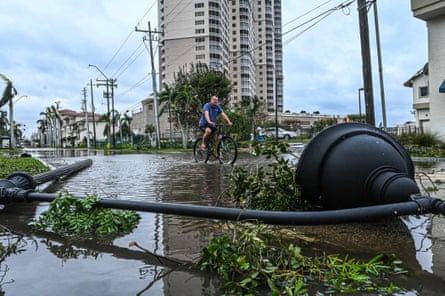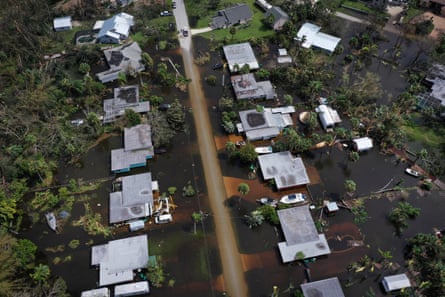As Carolinians braced for their dose of deadly Hurricane Ian on Friday, a massive swath of Florida lay underwater or covered in dangerous debris while one large population area allowed itself a small sigh of relief.
The 3 million-plus residents of the Tampa Bay area in south-west Florida, dominated by the cities of Tampa, St Petersburg and Clearwater, had battened themselves down expecting the first direct hit from a hurricane there in a century.
Instead, when one of the fiercest storms ever to hit the US swept ashore on Wednesday, after obliterating electrical power in Cuba, it made landfall 125 miles south of Tampa and hit Fort Myers.
Florida governor Ron DeSantis used one word, “destruction”, to describe the state of some of the barrier islands off the coast of Fort Myers. He said the coast there was hit with “a huge, huge wallop” and was wrecked by the ravages of winds up to 125mph and storm surges higher than anyone had seen before.

The Homeland Security Secretary, Alejandro Mayorkas, on Thursday late afternoon described the impacts of the tempest as “breathtaking”.
In low-lying areas around Orlando, 160 miles north-east of Fort Myers, with a trail of damage leading all the way from one to the other, freshwater flooding had turned roads into rivers and acres of countryside into lakes.
Rescue service officers in rubber boats searched in pelting rain for anyone trapped or marooned without supplies, proceeding cautiously in the deceptively calm water because of the risk of hitting sidewalk furniture such as mailboxes or street signs covered in 6-8ft of floodwaters.
Residents of St Augustine and up towards Jacksonville on Florida’s north-western Atlantic edge were wading through floodwater on Thursday evening as the devastation went coast to coast.
As the death toll started to tick up, with many of the effects of the hurricane still to be counted, Joe Biden warned that it could become the deadliest hurricane in Florida history.
“Many families are hurting today, and our country hurts with them,” the US president said on Thursday.
“We’re continuing to see deadly rainfall, catastrophic storm surges, roads and homes flooded, millions of people without power and thousands hunkered down in schools and community centers.
“They’re wondering what’s going to be left when they get to go home.”
DeSantis warned areas where the hurricane had already passed that there was still mortal danger.

“Falling power lines that are down. Falling trees – there are a lot of hazards right now,” he said. Fires and electrocutions are common well after storms have passed an area by, leaving chaos and power outages behind and many relying on emergency generators.
Forecasters expect Ian to strengthen again over Florida’s Atlantic coast and make landfall for a third time in South Carolina on Friday morning. It weakened from hurricane to tropical storm status earlier on Thursday and then revved back up to a category one hurricane by early evening as it headed north.
Back in Fort Myers and nearby Naples on Florida’s south-west coast, facing the Gulf of Mexico, many buildings have been completely flattened. Storm-tossed boats and hundreds of trees, houses smashed to smithereens and wrecked cars are strewn across huge expanses.
Jennifer Campbell, the fire marshal in Fort Myers Beach, said the scene was one of “absolute devastation”.
“There’s barely anything left,” she told the Tampa Bay Times.
Resident Kevin Behan had to race upstairs in the building he was sheltering in to escape flooding and as the storm hit he told the paper that “it sounded like there was a tornado coming every five minutes”.
And the aftermath looked like “somebody took an atom bomb and dropped it,” he said.

Meanwhile, for the millions in the Tampa Bay area who had been dreading yet fully expecting the storm of the century, there continues a nervous emerging from hotels where people had evacuated from earlier in the week as Ian bore down.
Many have lost power but considering they feared the kind of loss of life and destruction now being suffered elsewhere, the atmosphere late Thursday generally appeared to be one of relief tempered with sorrow and concern for fellow Floridians who weren’t able to dodge the bullet.
Few cars or people were out and about on Thursday, as there were downed power lines and branches everywhere that constituted a significant hazard, as the governor warned. Many were relying on food they had stored in coolers and were trying to conserve drinking and showering water.
Utility workers were fanning out late Thursday, as well as landscaping crews to cut through and clear fallen trees.
The streets had an eerie, abandoned feel, many buildings still boarded up and most people continuing to hunker down until the streets are made safe and they have a clearer idea of when they can venture home.
